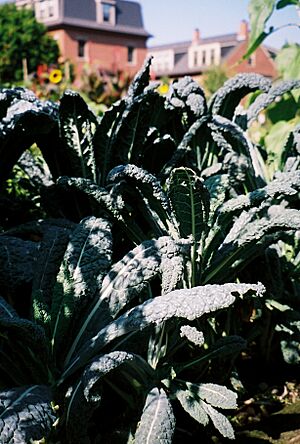Lacinato kale facts for kids
Lacinato kale is a special type of kale. It's also known by its Italian name, cavolo nero, which means "black cabbage." This name comes from its very dark green leaves.
This vegetable has been a big part of Italian cuisine for a long time, especially in the region of Tuscany. People also call it Tuscan kale, Italian kale, or even dinosaur kale. It's been grown in Tuscany for hundreds of years. Lacinato kale is a key ingredient in famous Italian soups like minestrone and ribollita.
Contents
What is Lacinato Kale?
Lacinato kale plants usually grow about 2 to 3 feet (60 to 90 cm) tall. Its leaves are a dark blue-green color and have a unique bumpy texture. Many people say it tastes a bit sweeter and more delicate than other types of kale. It also has a slightly earthy flavor.
Sometimes, this kale is called dinosaur kale. This is because its bumpy leaves might remind you of what dinosaur skin looked like! Its unique look can also make you think of plants from ancient times. Because of its great taste, many chefs love to use it in their cooking.
Cooking with Lacinato Kale
Just like most other types of kale, Lacinato kale is often cooked before eating. People usually blanch it first. This means quickly boiling it and then cooling it down. After blanching, it's often sautéed (cooked quickly in a little oil) with other tasty ingredients.
In some parts of Italy, like Campania, people often add anchovies when cooking it. Lacinato kale is great in pastas and soups. You can also eat it raw in a salad, which is a healthy choice!
Lacinato Kale in Tuscan Soups
In Tuscan cooking, Lacinato kale is a main ingredient in a hearty soup called ribollita. The word "ribollita" means "reboiled." This soup is often made with ingredients that were cooked the day before. It's a thick and filling meal.
In other countries, Lacinato kale has different names. In Dutch, it's called palmkool. This name refers to how the leaves grow from the stem, making the plant look like a small palm tree. In Sweden and Finland, it's known as svartkål or mustakaali, both meaning 'black cabbage'.
Growing Lacinato Kale
Lacinato kale has been grown in Italy since at least the 1700s. Gardeners really like this plant because of its beautiful color and interesting texture. Even Thomas Jefferson, an important figure in American history, grew Lacinato kale in his garden at Monticello in 1777.
The plant can grow up to two feet tall. Its long, strap-like leaves can be over 12 inches (30 cm) long and 2–4 inches (5–10 cm) wide. Gardeners usually pick the leaves from the bottom of the stem first. This makes the rest of the plant look even more like a small palm tree.


